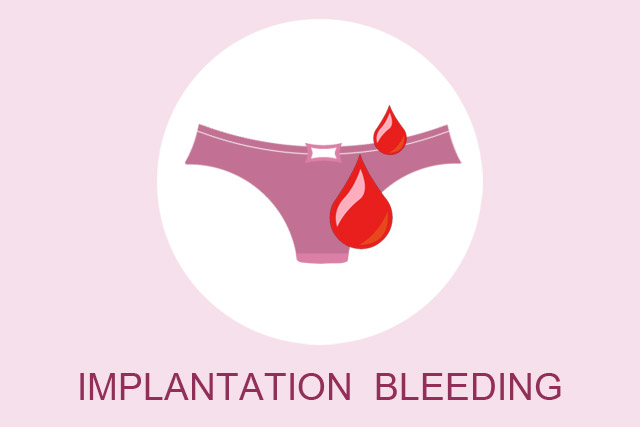Hoping for pregnancy, people try to distinguish any sign or symptom that may signal they’vesucceeded. Implantation bleeding is one of those appearing at the earliest. It is generally considered that around 15 – 25% of women do experience implantation bleeding. Therefore, having it is as normal as not having it.
Before we get down to explaining what it looks like, let’s get to know what it is and why implantation bleeding occurs.
Menstrual Cycle and Implantation Bleeding
Taking that the average duration of a menstrual cycle is 28 days, the ovulation typically happens in its middle, which is about two weeks after the beginning of your last period. Once released from the ovary, the ovum has 24 hours to be fertilized. If you have unprotected intercourse anywhere within a week before ovulation, there is a chance of conceiving a baby.
After fertilization, which happens in the fallopian tubes, the fertilized egg starts its journey to the uterus. This may take about five days. During all this time, the cell division process takes place, so when the ovum reaches the uterus, it is already called an embryo.
The process of its attaching to the uterine lining is called implantation. It usually happens 14 days after conception. This time often falls on the days when you are supposed to have your menstrual period bleeding. This is the reason many women confuse implantation bleeding with menses.
Early Detection of Pregnancy. Testing for Pregnancy
Aside from light bleeding in early pregnancy, you may also have some other early pregnancy symptoms. They are:
- light abdominal cramping;
- nausea;
- dizziness;
- tender breasts;
- headaches;
- unstable mood.
About 70% of pregnant women will have one or several of these early signs of pregnancy before they miss their period. Most of these symptoms will come in full power by the 6th gestational week.
Can you use a home pregnancy test once you notice vaginal bleeding that looks like implantation? Of course, you can, yet the reliability of the result won’t exceed 70 – 80%,based on how far your menses due date is. There is a chance that you receive a negative result because of the pregnancy term being very small.But if you wait until the day after you are supposed to have your menses, the likelihood of getting a false negative is only 1%.
How It Looks Like and How Long It Last?
If regular menses involve heavy bleeding, the characteristic feature of bleeding of implantation is its insignificance. Yes, you’ll have some bleeding and spotting, but its amount won’t be enough to fill the pad or a tampon. The light spotting, typically coming with implantation bleeding, appears due to the damage of minor blood vessels in the walls of the uterus, which happens when an embryo attaches to it.
The color of your vaginal discharge may range from light pink to brown discharge. Bright or dark red is not characteristic of this type of bleeding. If you notice any clots on your pad, you probably have your period.
Implantation bleeding continues for three days maximum, according to the American Pregnancy Association. But if the bleeding you’ve got differs from your typical periods in the amount of vaginal discharge, its duration, or the severity of cramping, a chance remains you do have implantation bleeding.
Bleeding in Early Pregnancy. When to See a Doctor?
Light bleeding in the first weeks after conception may happen for several reasons. One of them is related to the attachment of the fertilized ovum. Others may be related to changes in hormone levels, vaginal infection, excessive physical load, trauma of the vaginal mucous membranes during intercourse, and others.
If you feel fine overall, it’s usually not a reason for concern. Still, it’s recommended to call your OB-GYN for a consultation.
On the other hand, you should understand that not every desired pregnancy ends in a live birth. Statistics say that 10 – 15% of known pregnancies end in miscarriage. If this happens, you may experience heavy bleeding of dark red color with lots of blood clots. You may also experience abdominal cramping and dizziness.
Another reason for heavy bleeding in the first weeks of pregnancy is the rupture of an ectopic pregnancy. The symptoms of this dangerous condition include:
- extreme lightheadedness;
- faintness;
- heavy vaginal bleeding;
- severe pain on one side of the abdomen;
- low blood pressure.
Still, ectopic pregnancy rupture may be accompanied by internal bleeding that you won’t see. So if you have all the listed symptoms aside from bleeding, you should still seek medical attention. Only 1% of pregnancies are ectopic, and only 15% of them will cause a fallopian tube rupture.
Regardless of your symptoms, you shouldn’t hurry with making any conclusions. It’s important to consult a medical specialist to understand the causes of your condition. Anyway, you should keep calm.
What Does Implantation Bleeding Look Like? – Summing up
Implantation bleeding is one of the earliest and least known symptoms of pregnancy, especially in women pregnant first time. Still, it’s a reliable indicator of a new life developing inside you.




